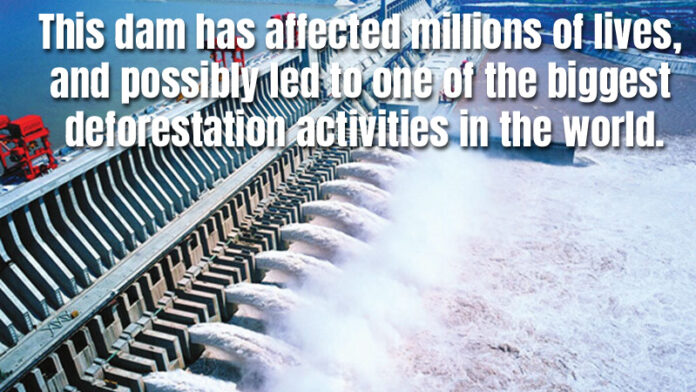When the Three Gorges Dam was built, 39 trillion kilograms of water from the Yangtze River built up behind it to 175 meters above sea level. This altered the Earth’s moment of inertia changed ever so slightly, causing the rotation to move more slowly. This is the same principle behind why figure skaters tuck in their arms to spin faster.
Three Gorges Dam, China crosses the Yangtze River in Hubei province, China. It the world’s largest hydroelectric power station by total capacity, which will be 22,500 MW when completed. When the water level is maximum at 175 meters (574 ft) over sea level (91 meters (299 ft) above river level), the reservoir created by the dam is about 660 kilometers (410 mi) in length and 1.12 kilometers (0.70 mi) in width on average. The total surface area of the reservoir is 1045 square kilometers, and it will will flood a total area of 632 square kilometers, of land. The reservoir will contain about 39.3 cu km (9.43 cubic miles) of water. That water will weigh more than 39 trillion kilograms (42 billion tons).
A shift in a mass of that size would affect the rotation of the Earth due to a phenomena known as the moment of inertia, which is the inertia of a rigid rotating body with respect to its rotation. The moment of inertia of an object about a given axis describes how difficult it is to change its angular motion about that axis. The longer the distance of a mass to its axis of rotation, the slower it will spin. You may not know it, but you see examples of this in everyday life. For example, a figure skater attempting to spin faster will draw her arms tight to her bodies, and thereby reduce her moment of inertia. Similarly, a diver attempting to somersault faster will bring his body into a tucked position.
NASA has calculated that the dam only slows the rotation by 0.06 microseconds, which is six hundredths of a millionth of a second. Our planet’s rotation speed actually fluctuates fairly often, as it can be influenced by earthquakes, the moon, and the climate change-induced movement of the North Pole.
It is not mind-shattering, but still quite impressive because the Earth’s rotation changes regularly with many changes. Every five years, the length of the day increases and decreases by approximately a millisecond. The mega quake in Japan in 2011, changed the Earth’s spin by 2.68 microseconds.
This dam has affected millions of lives, and possibly led to one of the biggest deforestation activities in the world. This structure has had its share of controversies, though they have been managed quite well.


















































